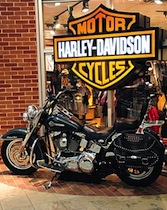 When you think of an iconic brand, what comes to mind?
When you think of an iconic brand, what comes to mind?
For example, if I said, “motorcycle”, what do you think of?
For most people, it’s a Harley-Davidson motorcycle (or perhaps a scene from the 1960’s film Easy Rider). Founded in 1903, Harley’s have maintained their distinct sound and design. The Harley-Davidson logo is also a popular tattoo design.
What you envision is determined by whether you think in images, sounds, feelings or words. Regardless of your how you formed your mental image of “motorcycle”, it is most likely a Harley, right?
How about other iconic brands?
- Sunglasses: RayBan – think Tom Cruise in Top Gun or Brad Pitt in Oceans 11.
- Cars: Porsche – distinctive European car designs since the 1950’s
- Theme restaurants: Hard Rock Café with its distinctive guitar-shaped logo and over 120 restaurants around the world
- Theme parks: Disneyworld
- Soft drinks: Coca Cola - the #1 brand in the world, year after year.
- Sneakers: Nike
- MP3 players: Apple iPod
- Electric guitar: Fender Stratocaster
Can you name other categories and examples?
In this short blog series I’d like to explore what it takes to become an iconic brand. From design, production, pricing and profitability, to marketing and staying ahead of the competition, how do iconic brands repeat this process year after year?
You might also like:
What Makes a Brand Iconic? (Part 2)
Harley-Davidson Goes Whole Hog with Customer Insight
Why Butterball is No Turkey on Thanksgiving
Are Brands Entering an Era of Truth in Advertising?
The Politics of Brand
